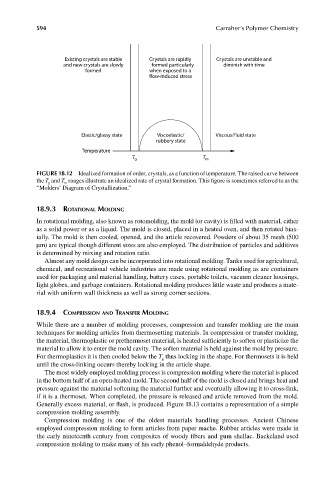Page 631 - Carrahers_Polymer_Chemistry,_Eighth_Edition
P. 631
594 Carraher’s Polymer Chemistry
Existing crystals are stable Crystals are rapidly Crystals are unstable and
and new crystals are slowly formed particularly diminish with time
formed when exposed to a
flow-induced stress
Elastic/glassy state Viscoelastic/ Viscous/fluid state
rubbery state
Temperature
T g T m
FIGURE 18.12 Idealized formation of order, crystals, as a function of temperature. The raised curve between
the T g and T m ranges illustrate an idealized rate of crystal formation. This figure is sometimes referred to as the
“Molders’ Diagram of Crystallization.”
18.9.3 ROTATIONAL MOLDING
In rotational molding, also known as rotomolding, the mold (or cavity) is filled with material, either
as a solid power or as a liquid. The mold is closed, placed in a heated oven, and then rotated biax-
ially. The mold is then cooled, opened, and the article recovered. Powders of about 35 mesh (500
μm) are typical though different sizes are also employed. The distribution of particles and additives
is determined by mixing and rotation ratio.
Almost any mold design can be incorporated into rotational molding. Tanks used for agricultural,
chemical, and recreational vehicle industries are made using rotational molding as are containers
used for packaging and material handling, battery cases, portable toilets, vacuum cleaner housings,
light globes, and garbage containers. Rotational molding produces little waste and produces a mate-
rial with uniform wall thickness as well as strong corner sections.
18.9.4 COMPRESSION AND TRANSFER MOLDING
While there are a number of molding processes, compression and transfer molding are the main
techniques for molding articles from thermosetting materials. In compression or transfer molding,
the material, thermoplastic or prethermoset material, is heated sufficiently to soften or plasticize the
material to allow it to enter the mold cavity. The soften material is held against the mold by pressure.
For thermoplastics it is then cooled below the T thus locking in the shape. For thermosets it is held
g
until the cross-linking occurs thereby locking in the article shape.
The most widely employed molding process is compression molding where the material is placed
in the bottom half of an open-heated mold. The second half of the mold is closed and brings heat and
pressure against the material softening the material further and eventually allowing it to cross-link,
if it is a thermoset. When completed, the pressure is released and article removed from the mold.
Generally excess material, or flash, is produced. Figure 18.13 contains a representation of a simple
compression molding assembly.
Compression molding is one of the oldest materials handling processes. Ancient Chinese
employed compression molding to form articles from paper mache. Rubber articles were made in
the early nineteenth century from composites of woody fibers and gum shellac. Baekeland used
compression molding to make many of his early phenol–formaldehyde products.
9/14/2010 3:43:41 PM
K10478.indb 594 9/14/2010 3:43:41 PM
K10478.indb 594

